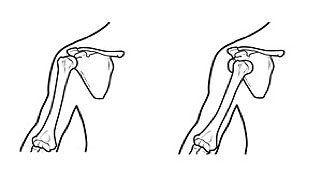Shoulder Instability / Dislocated Shoulder
Shoulder instability refers to shoulder dislocations or slipping of the shoulder joint (when the ball slides in and out of the socket). This may occur in a forward direction, backward direction, or in all directions (Multidirectional Instability). Forward instability is the most common, and usually results from a traumatic injury. Instability produces pain in the shoulder, can cause crunching in the joint, and over time can cause the cartilage and bones of the shoulder joint to wear away.

Left: Normal shoulder stability. Right: Head of the humerus dislocated to the front of the shoulder.
How does this happen?
Most commonly, shoulder instability results from a traumatic dislocation of the shoulder. This can result from a fall, a car accident, a seizure, or a sports injury. Multidirectional Instability (MDI) results from generalized ligamentous laxity, or being double-jointed, and weakness of the rotator cuff and muscles surrounding the shoulder joint.
How will we know that this is your problem?
The diagnosis of shoulder instability is made through a combination of history and physical exam. The history usually includes a memorable injury where the shoulder dislocated. The shoulder may come all the way out, or it may slip part way out and go back in on its own. Sometimes the shoulder needs to be put back in place in the Emergency Room with sedation. Examination of the injured shoulder reveals reproducible popping, clicking, and pain. With the arm overhead, one usually feels apprehension, or the feeling that the shoulder is going to come out of the socket. The diagnosis is confirmed with X-rays and MRI.
How can this be treated?
Dr. O’Brien treats all dislocations of the shoulder. Initial treatment for shoulder instability involves immobilization in a sling, and physical therapy and home exercises for good posture and strengthening of the muscles around the shoulder. Posture shirts and bracing may be beneficial. When multiple dislocations occur (recurrent instability), then surgery may be necessary. Most surgeries can be performed arthroscopically to repair torn ligaments and cartilage. When bone loss has occurred, more technical procedures involving bone grafting may be necessary.
Dr. Michael O’Brien performs surgery for shoulder dislocations and instability, and is fellowship trained in the field of shoulder reconstruction. He offers a wide range of surgical reconstruction options, and has excellent success in the surgical treatment of dislocating shoulders (see article below). He aims to get patients back to the activities they enjoy with a stable, painless, functional shoulder.
The Tulane Institute of Sports Medicine offers on-site X-Ray and MRI, as well as its own Physical Therapy department with licensed physical therapists, in order to ease your visit and speed your recovery.
¹Posterior and multidirectional instability of the shoulder. Instr Course Lect. 2009; 58:315-321.
²Arthroscopic management of posterior instability: evolution of technique and results. Arthroscopy. 2008; 24(4):389-396.
³Arthroscopic repair of anterior glenohumeral instability and rotator interval lesions. Orthop Clin North Am. 2003; 34(4):529-38.
